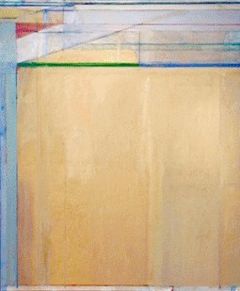 The most important American art exhibition of the 2008-09 season, Richard Diebenkorn: The Ocean Park Series, 1967 to 1985, goes up on October 11 at the Orange County Museum of Art in Newport Beach, California. Not New York, not Philadelphia, not Chicago, not even San Francisco. What gives here? The answer, as those who esteem Diebenkorn know all too well, is that his greatness has yet to be fully acknowledged by large tracts of the American art establishment. Why? Because he doesn’t fit into the Cézanne-Picasso-Pollock narrative that many critics and curators use to “explain” the history of twentieth-century art. He switched from abstraction to figurative painting when the New York School was at the peak of its popularity, then switched back just as abstract expressionism was giving way to Pop Art. As if all that weren’t bad enough, he had the poor taste to live in…California. How déclassé is that?
The most important American art exhibition of the 2008-09 season, Richard Diebenkorn: The Ocean Park Series, 1967 to 1985, goes up on October 11 at the Orange County Museum of Art in Newport Beach, California. Not New York, not Philadelphia, not Chicago, not even San Francisco. What gives here? The answer, as those who esteem Diebenkorn know all too well, is that his greatness has yet to be fully acknowledged by large tracts of the American art establishment. Why? Because he doesn’t fit into the Cézanne-Picasso-Pollock narrative that many critics and curators use to “explain” the history of twentieth-century art. He switched from abstraction to figurative painting when the New York School was at the peak of its popularity, then switched back just as abstract expressionism was giving way to Pop Art. As if all that weren’t bad enough, he had the poor taste to live in…California. How déclassé is that?
In this week’s “Sightings” column, which appears in tomorrow’s Wall Street Journal, I use the Orange County retrospective as an occasion to discuss the insidious effect of historical narratives on the immediate experience of art. Too many people believe what they read instead of seeing what they see, and Diebenkorn is one of many artists whose reputation has suffered as a result. If you want to know why that happens, pick up a copy of Saturday’s Journal and read what I have to say.
UPDATE: Read the whole thing here.
Alas, I made a not-so-little mistake in this week’s column: Orange County’s Diebenkorn show goes up next October 11, not this October 11. Sorry about that. Plan ahead!
Terry Teachout on the arts in New York City
